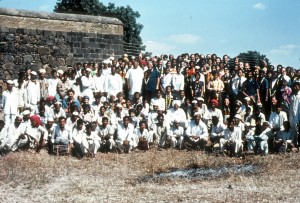Bringing a Strategic Thinking Process to Communities and Organizations
To build a movement that could play a significant role in shaping the major global changes occurring in the early 1960s, the Institute needed ways to think strategically itself and to enable the movement to do so. This strategic thinking had to be done on both the most globally comprehensive scale and the most local scale. Serious staff research and experimentation in processes that could achieve this began at a very early point.
Starting in the early 1960s, the staff tested planning approaches on themselves and in the Fifth City Community Project. Underlying presuppositions and processes formed here would shape all its future programs. In the late sixties, it did major strategic and tactical planning on engaging local churches in new forms of ministry and social action. It led a mass study project across several countries to research, map and describe the dynamics of society at all levels and to discover how substantive change might be introduced into these dynamics.
It called a shift in its own strategy at that time a “Turn to the World,” signifying an expansion of its own thinking and planning. From a primary focus on awakening and engaging the religious community in social change, the new strategy recognized the importance of business and professional leaders as agents of change. New courses called on these groups to look squarely at the suffering in the world crying out for serious change and in beginning to think practically about how such changes might be locally initiated. One of these, called the New Individual in the New Society, would become the LENS Seminar or Living Effectively in the New Society, with major corporations as its primary target audience.
At the same time, the Institute was implementing its own strategic plan for expanding the Fifth City Community Project. Its ambitious plan called for initiating in rapid succession twenty-four similar Human Development Projects, primarily in the distressed rural villages of what was then called the third world. These would reflect a wide diversity of nations, cultures and issues but apply a common strategic planning process for their launch events and subsequent implementation activities.
Major work in developing ICA’s strategic planning process went on simultaneously in these two distinct arenas, with insights in one often influencing the other. What emerged was a distinctive process that took the title, Technology of Participation or ToP–the name by which it continues to be known today.
This process began with facilitators helping a group of executives or a community discover its shared vision of a positive future. That then allowed the group to see the underlying contradictions preventing that vision from becoming reality. These in turn became the basis for the formation of multiple tactical actions, broad strategies, specific programs and practical implementation designs. The methods used were highly participatory and generated an outflow of engagement, energy and creativity among all participants.
While this approach to strategic planning drew on elements present in other processes, its contradictional thinking component was a unique contribution to the field. It enabled a group to deal positively with many serious but “taboo” topics that would otherwise remain unmentioned and unaddressed in its planning–and therefore often derailed a group’s best subsequent efforts to effect significant change.
The product of a corporate or agency LENS was not only a plan that had a better chance of actually being implemented than most–it also often had an impact on the nature of the organization involved. Experiencing the power of the participatory processes used in the LENS planning could occasion changes in its leadership style going forward, as well as in the sense of ownership of the enterprise and its mission by staff and employees.
In the village consults, a team of facilitators and local and international consultants assembled on site for a week or more to hold interviews and explore with members of the community their hopes for its future and the issues it was facing, as well as to look for creative new options for its economic, political and cultural development. This information fed into the same kind of participatory process sessions as the LENS, in this case usually held in the evenings and under a large tent, so that the maximum number of village residents would be present. Once again, the strategic thinking process produced not only a concrete plan of action, with teams ready to begin implementing it, but an often dramatic change in lifting the spirits of the people and their mode of interacting with one another.
ICA’s innovations in participatory strategic thinking and planning brought a critical planning and engagement method to ordinary people in thousands of communities and organizations around the world. It has continued to evolve since its early formats and remains a key component of ICA’s ToP services worldwide to this day.

